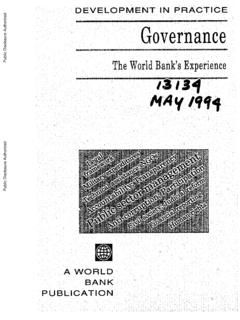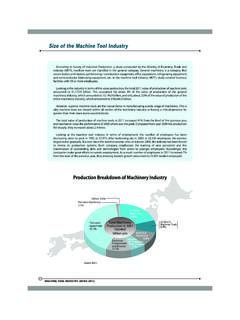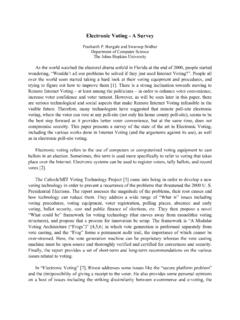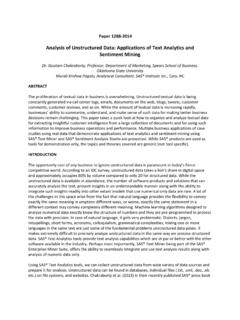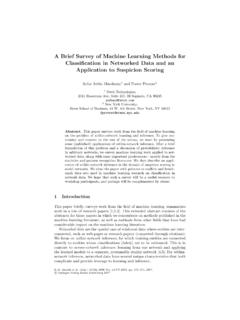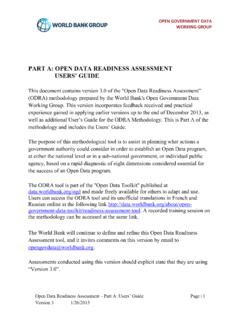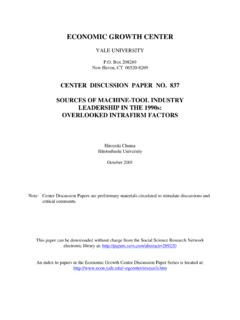Transcription of Global Survey of Development Banks - World Bank
1 Policy Research Working Paper5969 Global Survey of Development BanksJos de Luna-Mart nezCarlos Leonardo Vicente The World BankFinancial and Private Sector DevelopmentFinancial Systems PracticeFebruary 2012 WPS5969 Public Disclosure AuthorizedPublic Disclosure AuthorizedPublic Disclosure AuthorizedPublic Disclosure AuthorizedPublic Disclosure AuthorizedPublic Disclosure AuthorizedPublic Disclosure AuthorizedPublic Disclosure AuthorizedProduced by the Research Support TeamAbstractThe Policy Research Working Paper Series disseminates the findings of work in progress to encourage the exchange of ideas about Development issues.
2 An objective of the series is to get the findings out quickly, even if the presentations are less than fully polished. The papers carry the names of the authors and should be cited accordingly. The findings, interpretations, and conclusions expressed in this paper are entirely those of the authors. They do not necessarily represent the views of the International bank for Reconstruction and Development / World bank and its affiliated organizations, or those of the Executive Directors of the World bank or the governments they Research Working Paper 5969 Historically, Development Banks have been an important instrument of governments to promote economic growth by providing credit and a wide range of advisory and capacity building programs to households, small and medium enterprises.
3 And even large private corporations, whose financial needs are not sufficiently served by private commercial Banks or local capital markets. During the current financial crisis, most Development Banks in Latin America, followed by Asia, Africa, and Europe, have assumed a countercyclical role by scaling up their lending operations exactly when private Banks experienced temporary difficulties in granting This paper is a product of the Financial Systems Practice, Financial and Private Sector Development Vice Presidency. It is part of a larger effort by the World bank to provide open access to its research and make a contribution to Development policy discussions around the World .
4 Policy Research Working Papers are also posted on the Web at The authors may be contacted at or to the private sector. Despite the importance of Development Banks during crisis and non-crisis periods, little is known about them. This Survey examines how Development Banks operate, what their policy mandates are, what financial services they offer, which type of clients they target, how they are regulated and supervised, what business models they have adopted, what governance framework they have, and what challenges they face.
5 It also examines the countercyclical role played by Development Banks during the recent financial crisis. This Survey is based on new data that have been collected from 90 national Development Banks in 61 countries. Global Survey of Development Banks Jos de Luna-Mart nez and Carlos Leonardo Vicente1 Keywords: Development Banks , banking, emerging economies JEL Classification: G21, G28, H11, H81 FSE 1 Jos de Luna-Mart nez is a Senior Financial Economist at the Financial and Private Sector Development Vicepresidency of the World bank Group.
6 Carlos Leonardo Vicente is a Financial Sector Specialist at the Financial and Private Sector Vicepresidency of the World bank Group. Table of Contents Acknowledgements .. 1 Introduction .. 2 1. Sample and Methodological Notes .. 4 DBs by year of establishment .. 6 Size of DBs .. 6 Countercyclical Role of DBs .. 8 3. Ownership and Funding .. 9 Funding .. 10 4. Mandates, Business Models and Financial Products .. 11 Mandates .. 11 Economic Sectors and Clients Targeted by DBs .. 12 Lending Models: First-Tier and Second-Tier Lending.
7 14 5. Asset Quality and Return .. 17 6. Corporate governance arrangements .. 19 7. Regulation and Supervision of DBs .. 21 8. Challenges for DBs .. 22 Conclusions .. 23 References .. 26 Annex .. 27 List of Figures Figure 1. DBs by Year of Establishment .. 6 Figure 2. DBs by Assets in 7 Figure 3. Loan Portfolio of DBs .. 8 Figure 4. Percentage of State Ownership in DBs .. 9 Figure 5. Economic Sectors Targeted by DBs .. 13 Figure 6. Types of Clients Served by DBs .. 13 Figure 7. DBs lending models.
8 14 Figure 8. Lending Products Offered by DBs .. 15 Figure 9. Distribution of DBs by levels of NPLs .. 18 Figure 10. Return of Assets and Equity .. 19 List of Tables Table 1. Survey Respondents by Region and Country .. 4 Table 2. Market Share of Selected DBs in 2009 .. 7 Table 3. Credit Growth Rate in DBs (2007-2009) .. 9 Table 4. Funding Features of DBs .. 10 Table 5. Mandates of DBs .. 11 Table 6. Maximum Loan Term Offered by 16 Table 7. Transparency of DBs .. 21 Table 8. Challenges Faced by DBs .. 23 1 Acknowledgements We wish to acknowledge the invaluable contribution of Octavio Peralta, the Secretary General of the World Federation of Development Financial Institutions (WFDFI), who enthusiastically supported us in all stages of this project and provided us access to the Development Banks affiliated with the WFDFI.
9 We would like thank all the senior officials of the Development Banks who participated in this Survey and shared their data and valuable insights with us. We express our gratitude to our World bank colleagues - Mario Guadamillas, Martin Cihak, Cesar Calderon, James Seward, Consolate Rusagara, David Scott, and Roberto Rocha -, as well as to Romy Calderon (Latin American Association of Development Banks ), Fernando de Olloqui (Inter-American Development bank ), Enrique Florencio (WFDFI), and Miriam Roemers (European Association of Public Banks ) for their comments and feedback.
10 Any errors or omissions in the data or interpretations are only attributable to us. 2 Introduction In spite of the wave of privatizations of state-owned financial institutions (SFIs) that has taken place over the past 30 years, SFIs still constitute an important part in the financial system. On average, they account for 25% of total assets in banking systems around the World . In the European Union, for example, SFIs represent 30% of the total financial system (Schmit, 2011). In the so-called BRIC countries alone Brazil, Russia, India, and China the market share of SFIs is substantially higher.
